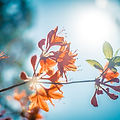Established in the 1940s and incorporated in 1972, we are an active chapter that serves the greater Tampa Bay and Brandon areas and its suburbs.

Tips to Help You Get the Most Out of Field Trips
Field checklist of the birds of Hillsborough County
The official source on the taxonomy of birds found in North and Middle America, including adjacent islands. This list is produced by the North American Classification Committee (NACC).
It’s easy to begin birdwatching in your own backyard and while traveling. The Audubon Society provides a lot of resources to get you started. The most basic equipment for spotting and appreciating birds is a good pair of binoculars, a notepad, and an identification guidebook.
This webinar was presented on May 4, 2020 to Florida Wildflower Foundation members and friends by Dr. Doug Tallamy, a professor in the Department of Entomology and Wildlife Ecology at the University of Delaware and the author of the popular book, "Bringing Nature Home." Join us to learn why we must add native plants to our yards and landscaping.
When selecting herbs and plants for your hummingbird garden, it’s important to diversify your choices and consider the ease of planting and maintenance, early or long blooming periods and attractiveness of foliage. With careful planning, you will be awarded later with happy hummers throughout your garden.

Reporting Tagged Vultures
Help track vulture movements, especially around airports, to learn how to prevent collisions between vultures and aircraft. If you see one, grab your binoculars and try to read the alphanumeric code on the tag. Then call (352) 375-2229 and report it. They'll want to know the date, location and code from the tag. Thanks for helping keep all birds safe!
As part of a collaborative study to investigate the movements, survival and site fidelity, biologists have marked adult lesser yellowlegs with colored leg bands and unique alphanumeric leg flags. In addition, tracking devices were attached to a proportion of the banded adults.
Scientists have banded tens of thousands of shorebirds since the mid 1990’s -- mostly red knots, semipalmated sandpipers, ruddy turnstones, and sanderlings -- resulting in a growing database of sightings along the Atlantic Flyway describing their migration routes, nesting and wintering areas. Your observations will contribute greatly to this important information.
More than 25% of North American birds (nearly 3 billion individuals) have vanished since 1970 due to loss of habitat, domestic cat depredation, collisions, pesticide use, and climate change. As indicators of environmental health, their loss signals an ecological crisis. Their loss is our doing, and so it's up to us to help them survive. Want to know more? Visit https://www.birds.cornell.edu/home/seven-simple-actions-to-help-birds/
Bring birds to your home today by growing native plants.
With Audubon's Native Plant Database, you can find the best plants for the birds in your area. Growing bird-friendly plants will attract and protect the birds you love while making your space beautiful, easy to care for, and better for the environment. Explore all of our native plant resources here.
Since the inception of the Duck Stamp program in 1934, over 6 million acres of wetland and grassland waterfowl habitat have been protected. 98¢ out of every dollar generated by the sale of Duck Stamps goes directly to purchase or lease habitat for protection in the National Wildlife Refuge System. BUY YOURS TODAY!










